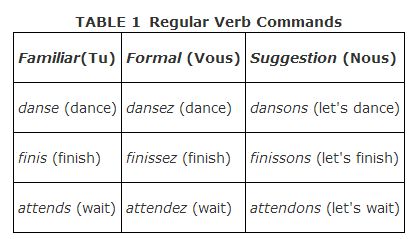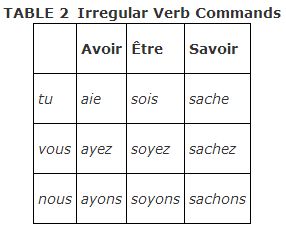The command form is also known as the imperative. “You” is the understood subject of a command and is, therefore, omitted as it is in English. ( Tu and vous are the two ways to say “you” in French.) Use tu, the familiar command, when speaking to one friend or family member. Use vous, the polite command, when speaking formally or when directing the command to more than one person, no matter what their relationship to you.
Forming commands
To form a command, simply drop the subject pronoun and use the proper verb form that would match the pronoun you are dropping, as shown in Table 1.

- Regarde cette vue! (Look at that view!)
- Choisis ton dessert! (Choose your dessert!)
- Descendez du bus! (Get off the bus!)
The nous form of the verb (without the subject) may be used to suggest “let's”:
- Allons à la plage! (Let's go to the beach!).
Note that the tu command of ‐er verbs (and verbs conjugated like ‐er verbs) drops the final ‐ s from the conjugated verb in both regular and irregular verbs, except when followed by the adverbial pronouns y (there) and en (some, of, about, from, it, or them).
- Mange du pain. Manges‐en. (Eat some bread. Eat some.)
- Va à l'école. Vas‐y. (Go to school. Go there.)
- Offre‐lui une boisson. (Offer him/her a drink.)
- Ouvre la porte. (Open the door.)
Three common irregular verb commands are shown in Table 2.

Here are examples of the irregular commands in sentences:
- Aie confiance! (Have confidence!)
- N'ayez pas peur! (Don't be afraid!)
- Ne soyez pas méchant! (Don't be nasty!)
- Sache la vérité! (Know the truth!)
Negating commands
To negate a command, put ne and the negative word around the verb and any pronouns that may precede it:
- Ne parle pas. (Don't speak.)
- Ne lui parle pas. (Don't speak to him/her.)
- N'y va pas. (Don't go there.)